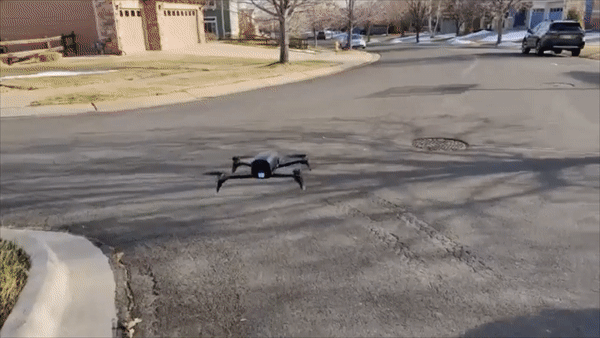An autonomous, vision-based Bebop drone. Our Intro to Robotics (CSCI-3302, at the University of Colorado Boulder) final project.
This project consists of ROS-based autonomous CNN-Based Navigation (via Dronet) of a Bebop Quadrotor with SSD300 Object Detection and Semi-Direct Visual Odometry. New: We now have semantic segmentation with DeepLabv3 working as well! The whole vision suites only requires the Bebop's camera to run, no other sensors on the drone. Additionally, the object detection and semantic segmentation use the python torch2trt plugin, which is a PyTorch to TensorRT converter that runs optimized models faster than ever.
-
bebop_autonomy- The ROS driver for the Parrot Bebop drone. Is the base of this whole project. A link can be found here -
catkin_simple- Catkin Simple ROS package that is used with Dronet. Additionally, a link to the Github repo can be found here. -
dronet_control- ETH Zurich's Dronet control package for sending commands to thecmd_velfor the Bebop drone. A link to all of Dronet can be found here -
dronet_perception- Runs the actual Dronet model (best if done on GPU), which outputs a steering angle and collision probability. -
rpg_svo- The semi-direct visual odometry package in ROS. Developed at ETH Zurich; the repository can be found here -
rpg_vikit- Some vision tools for this project. The link to the repo is here.
Each package with the bebop_ws ROS workspace requires some different work to be done to get it fully working with the whole suite. They are listed below (firstly, make sure that you have ROS installed).
-
bebop_autonomy- in-depth docs here- Run
sudo apt-get install ros-<ros-distro>-parrot-arsdk
- Run
-
catkin_simple- simply required for being able to build Dronet, which usescatkin_simple -
dronet_control- ROS package that takes the CNN predictions from Dronet to send the correct commands to the Bebop drone. -
dronet_perception- ROS package that runs the actual Dronet model.- Requires
tensorflow,keras,rospy, opencv, Python's gflags, and numpy/sklearn. - More information about the Dronet code and setup can be found here.
- Requires
-
rpg_svo- There are some extra steps that you will need to follow; these are detailed well atrpg_svo's wiki. Theg2opackage is optional. Additionally, the step to clonerpg_svois not needed as it already exists in this repo. -
rgp_vikit- Nothing here.
We also have two Python files in this repo that are used for easier ROS control and for the object detection model, which includes csci_dronet.py and robotics.py.
-
csci_dronet.py- This Python file serves as an easy way to send publish (in ROS) to one of three topics. Requiresargparse,std_msgs, androspy, if you haven't installed them already. Usage will be detailed in a later section. -
bebop_object_detection.py- This Python file runs the SSD-300 object detection model in real time. Its usage will also be detailed in a later section. This requires: -
bebop_semantic_segmentation.py- This Python runs the DeepLabv3 semantic segmentation model in real time (not as fast as the object detection model). Usage will be detailed later. It requires the same packages asbebop_object_detection.py.
cd bebop_ws
catkin build
- If you have the above packages/dependencies installed, then
catkin buildshould work fine, however, it is possible that there is some missing ROS package (if there's an error). In that case, a common way to fix this issue is to runsudo apt-get install ros-<your-distro>-<package-name>. Then, retry the previous command.
Also do:
- In
bebop_ws/devel/include:
sudo ln -s /opt/ros/<ros-distro>/include/parrot_arsdk parrot_arsdk- In
bebop_ws/devel/library:
sudo ln -s /opt/ros/<ros-distro>/lib/parrot_arsdk parrot_arsdkecho "export LD_LIBRARY_PATH=<path-to-bebop-ws>/devel/lib/parrot_arsdk:$LD_LIBRARY_PATH" >> ~/.bashrcWe explain how to use this open sourced work and how to integrate it with our work together.
First, make sure that you have a working Bebop2, and connect to its Wi-Fi network. Also, make sure that you successfully completed the build steps listed above.
cd bebop_ws
source devel/setup.bash
cd src/dronet_perception/launch
roslaunch full_perception_launch.launch
In another terminal, or using tmux (recommended):
cd bebop_ws/
source devel/setup.bash
cd src/dronet_control/launch
roslaunch deep_navigation.launch
-
Using
tmuxor another terminal: -
python bebop_object_detection.pyorpython3.5 bebop_object_detection.py -
This should open a window that shows the detections from the Bebop drone in real time. Having a GPU helps here.
Here's an example:
-
Using
tmuxor another terminal: -
python bebop_semantic_segmentation.pyorpython3.5 bebop_semantic_segmentation.py -
This also should open a window that shows segmentation results real-time.
Here's an example:
- Again, using
tmuxor another terminal:
cd bebop_ws
source devel/setup.bash
roslaunch svo_ros live.launchFor visualization:
rosrun rviz rviz -d bebop_ws/src/rpg_svo/svo_ros/rviz_config.rviz
Now we can begin the real fun work. Below is a list of commands you can use once the above programs are running.
rostopic pub --once /bebop/takeoff std_msgs/Empty - takes off the drone
rostopic pub --once /bebop/state_change std_msgs/Bool "data: true" - enables dronet control. SVO and SSD will continue to run.
rostopic pub --once /bebop/state_change std_msgs/Bool "data: false" - stops dronet control, perception will still run.
rostopic pub --once /bebop/land std_msgs/Empty - lands the drone regardless of if dronet is enabled or not.
Additionally, we can run python csci_dronet.py --option=takeoff, python csci_dronet.py --option=land, python csci_dronet.py --option=dronet_start, or python csci_dronet.py --option=dronet_end to takeoff, land, start, and stop dronet, respectively.
Dronet in action. It follows the road, and thankfully stops when one of us gets too close. The Bebop doesn't listen to us, but Dronet's collision probability from its forward-facing camera was high enough so that the drone stopped, and disaster was averted.
The convolutional neural network is influenced by edges (detailed more in the paper) and is clearly moving parallel to the edge of the road here.




